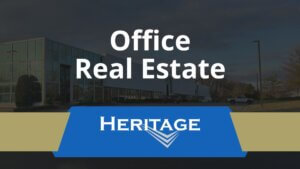Multifamily properties (apartment buildings) are a favored investment option for good reason and one that we have invested in and in which we are looking to make further investments. Multifamily investments are often compared to the bond market within the realm of real estate due to the overall size of the asset class relative to other property types and their general stability over time.
Similar to how the bond market holds a significant weight within the financial world, , multifamily real estate occupies a substantial portion of the property market compared to other types of investments, comprising roughly 42% of the US market.
Return profiles for multifamily properties are different from other real estate asset classes and they are generally considered to be safer. If you have a property with 200 residential tenants in it, you are not going to lose 200 tenants—you might lose ten or fifteen during a downturn – whereas industrial with fewer tenants (except small bay flex – the multifamily of the industrial world) or office investments often have much larger, single tenants whose termination of leases could have larger overall impact on returns – manageable by professional real estate investors like ourselves, but with different risk profiles. Additionally there is a shortage of housing in almost every market.
Multifamily investments can be time and capital intensive, especially value-add opportunities, because we have to renovate multiple units – new carpeting, new flooring, new light fixtures, new refrigerators, ovens – the works. Maybe we have to paint everything due to wear and tear and change out carpets and make repairs when tenants vacate. But with professional management and the right properties, multifamily fits all the compounding growth metrics we seek.
Our next investment is under contract. Please join the waitlist for priority access when the deal goes live.
Overemphasized Distress
In terms of distress, for example during the Global Financial Crisis or during the two-year period from early 2022 when interest rates started rising, we believe the impact on multifamily real estate investment opportunities should not be overrated or oversold. In our view, distress primarily affects those operators who make proforma assumptions that are unrealistic and whose investment theses and debt useage tend more towards short term returns rather than keeping an eye on protecting investor capital and long-term stability rather than those driven by fees instead of focusing on long-term growth fundamentals.
Those are the sponsors who get hurt when the real estate cycle turns against them. That said, if 5% of the market goes into stress, the other 95% are doing just fine which speaks to our sense that downcycle pessimism about multifamily investing is often overblown. To put it another way, we avoid aggressive underwriting, preferring steady growth over the long run versus trying to time the market because we believe in the viability of the asset class provided it is approached, and underwritten, with a long-term perspective.
Indeed, our portfolio used to be heavy in multifamily, but we cycled out of it after making huge gains by focusing on tertiary markets or markets that were unloved.
Heritage's Journey Through 10,000 Multifamily Units
When our current leadership took over the company's reins, we shifted focus largely to triple net, industrial leases.
After market conditions changed, we began to ponder a pivot back into multifamily. That ended up happening when we received a call about an office building we owned in Newark, NJ. Prudential was our major tenant there, and we were approaching the last five years of their lease. Prudential was planning on building a new headquarters in the market with significant government incentives.
Considering the lease term left and when our loan matured, we thought the wisest move would be selling the property because refinancing and retenanting the property could pose significant challenges down the line.
Once we successfully got the property under contract and secured the funds from its sale, the question arose about where to invest this capital next. Drawing inspiration from where it all began for Heritage—in multifamily real estate—we sought to return to our roots.
Given the stage in the real estate cycle at the time at the end of the Great Recession, we felt that it was a particularly compelling moment to reevaluate multifamily investments, provided they are acquired at the correct valuation. In short, we felt buying 1000 multifmaily units in Raleigh, NC with average rents of $600 a month was a better credit risk than one of the largest insurance companies in the United States.
The Scenario
It was an intriguing scenario – we stumbled upon three buildings in Raleigh that caught our attention. We decided to meet the seller in their office, amusingly located on a second floor above a pizza shop. With limited information at hand and understanding they had never ventured into an apartment deal before, we resorted to an old-fashioned approach that our principals had learned many years ago: if you cant make the real estate deal make sense on the back of a napkin , it is not worth buying.
This meant considering the rent roll, adjusting for a 5% vacancy collection, accounting for 45% expenses, and aiming for a compounding return of 7% per annum. Our team agreed it was a great deal given we could borrow at 3.5%.
The napkin approach was simple - no need for complicated spreadsheets. We were looking for a basic apartment deal with satisfactory cash-flow from the get-go. From there, we would strategize on value additions to each unit and anticipate the premium these renovations would fetch us as market conditions evolved. However, even with the napkin approach, we still did our detailed financial analysis as a back up to the napkin. But the napkin is rarely wrong.
Despite warnings from others about investing in what at the time they termed as a tertiary market like Raleigh, we saw potential where others did not. Our strategy was straightforward: bet on workforce housing with tenants who could afford rents between $500-$600 per month rather than chasing after A-class assets or high-income tenants. It also proved what we like to call the rule of small numbers. It is easier to move a $600 a month rent 30% to $780 a month, than to move a $2000 a month rent to $2600.
After all, people always need somewhere to live. On a higher level, this philosophy attracted us towards multifamily investments in secondary markets which at that time seemed like safer bets.
Executing our value-add plans diligently allowed us to grow substantially; at our peak owning nearly 10,000 units across various states. The essence of our success lay in understanding the fundamentals of cash flow management while preparing for eventualities like turnover rates and maintaining efficient staff management practices.
Looking for Opportunities
We found that the environment for acquiring multifamily assets became increasingly competitive and many of the opportunities we saw sell were at prices that were higher than makes sense to us. Heritage’s history included industrial real estate, we let our direction be determined by investing disciplines which have always been part of our DNA – we seem to have an ability to sleuth out what is next – and we have gravitated towards this asset class because we find dealing with businesses rather than individuals more predictable and less volatile.
With regard to the Raleigh project: that was the right thing to do at the time and in that specific market; by early 2024 we started to feel differently. We might look at rents now and think that they are expensive and question how people are going to afford those rents on a personal basis. Back then it was different; we thought the rents were cheap compared to what people could afford.
Due Diligence
When it comes down to conducting due diligence on a property that might be thousands of miles away, one of our first steps is comparing its in-place rents not only with its immediate competition but also within a broader market context spanning 20 or 30 miles.
With today’s cloud-based systems, it is feasible to expand this data search even further. It is also important to check out the renovation status of the units - if the owner claims it has been renovated (sometimes repeatedly over years), we lean towards purchasing based on cash flow rather than potential renovation gains since turnover, affordability and occupancy became key.
Understanding any capital needs is also critical. Engaging local brokers for their insights on the location and asset specifics often proves beneficial. If there are instances where assets are in special servicing and where we have an inside track to the servicers, we leverage such conversations.
A comprehensive assessment also involves scrutinizing potential obstacles that have previously hindered full occupancy, examining shifts in major job markets affecting tenant movement, and understanding rent ceilings alongside adjusting for capped rents in underwriting scenarios based on these dynamics. Operating expenses today can often exceed 50% or more, making them another critical consideration together with tax assessments anticipated post-purchase and projected insurance costs.
Property Management
In managing our properties remotely, we have adopted a strategy that involves utilizing property managers who not only bring a significant operational footprint to the table but, in some cases, also co-invest in the projects. This arrangement ensures they have skin in the game, keeping their dedication high since they own a portion of the equity, typically around 5%.
Ensuring our interests are aligned and maintaining a level of control where we can terminate their involvement if necessary due to cause has proven particularly effective. The core principle here is accountability. We actively asset manage by making unannounced visits and meticulously reviewing reports to ensure standards are met or exceeded.
One of the most challenging aspects of managing multifamily properties encompasses staff turnover and dealing with evictions along with ensuring tenant safety in varied markets. Creating a strong sense of community through tenant activities while navigating these complexities underscores why we lean towards third-party property management; it affords us peace of mind without disrupting personal hours over immediate crises—allowing others to handle emergencies while we strategize from a broader perspective.
Value in Overcapitalization
When we approach an acquisition, one of our strategies includes building in a significant amount of excess cash into the sources and uses. Essentially, even if the property appears to be in good condition—say it has a new roof and around 80 to 90% of the HVAC units are newly installed—we still allocate additional dollars for various potential needs.
Some of this fund might be earmarked specifically for unit renovations if we deem it necessary. However, it is crucial for us to have readily available funds for unforeseen expenditures such as replacing hot water heaters or addressing sections of the roof that may need attention unexpectedly.
We prioritize being prepared so that we do not have to wait on processing insurance claims following events like storms.
Our overarching aim is always centered around keeping our residents satisfied. To achieve this, having liquid cash at hand enables us to execute necessary repairs or improvements swiftly. There are occasions when we might discover something beneficial for the property that was not initially included in our business plan—an opportunity we had not anticipated. Therefore, maintaining a financial buffer is invaluable not only for emergencies but also for seizing unexpected opportunities that can enhance the value and appeal of our properties.
Maintaining this ‘rainy day fund’ means sometimes we end up with more money than ends up being utilized according to original projections. In such instances, where the surplus funds are not needed, we make it a point to return them back to our investors—a practice we have followed over time. We believe that it is far more preferable to have access to too much funding rather than facing a shortfall and having no choice but to issue capital calls to investors—a scenario no one wants.
Biggest Mistakes in Multifamily
In the two year period prior to early 2024, we observed that many multifamily sponsors had become a lot more aggressive in their assumptions. This shift happened as prices increased alongside interest rates. In order to keep syndicating deals amidst these changes, some sponsors took shortcuts. They either grew expenses at a significantly slower rate than needed or did not account for growth in expenses at all, even when, in some instances, expenses outpaced rents by two or three times. This discrepancy was particularly notable with insurance and payroll costs and compounded to spiking renovation costs.
One of our strategies has always been to take full-term, fixed-rate debt to avoid unforeseen financial strains. Currently, people are faced with the need to replace interest rate caps, which is turning out to be an extremely expensive endeavor. Though we hope that with the Federal Reserve's actions these costs will decrease over time, it remains a significant challenge for many.
Renovation Blues
Moreover, we have always questioned the feasibility of continuously renovating an apartment. For example, we have seen assets that have traded multiple times to syndicators over a short, say 10-12 year period, where each sponsor’s business plan was to renovate units and re-rent them at higher rents.
This makes no sense to us. It seems unsustainable and hard to understand from a business standpoint that the same property could yield sustainable returns from a sequence of owners all planning to do the same thing as the last. Yet, despite these concerns, many are still drawn into apartment investments without fully considering the potential pitfalls.
Misaligned Interests
When looking at how multifamily deals are marketed today, you will often find them showcasing attractive multiples or internal rates of return (IRR). However, these projections frequently rely on assumptions that are not guaranteed and that become uncontrollable post-closure of deals. Given that most sponsors aim for shorter holding periods to elevate their IRRs – thereby maximizing the optics of their profit margins – there arises a misalignment of interests between investors and multifamily syndicators.
Our approach has diverged from this trend; rather than advertising potential IRRs aggressively – although we compute them as industry standard requires – our focus is on cash flow first and a multiple of equity. We believe prioritizing cash flow provides a more reliable metric for investment decisions compared to merely chasing high IRR figures based on speculative projections.
Conclusion
One of our strengths is in having a good sense of what is overvalued and what is undervalued – and of course, we would rather be somewhere where the asset in question is undervalued. We are always looking for new opportunities because there is no secret sauce other than always keeping an eye out for value.
As for multifamily versus industrial investing, multifamily is a great asset class long term. We are strong believers in multifamily because there is a persistent shortage of housing in this country and having chronic, sustained shortages in any supply side of an equation is advantageous.



